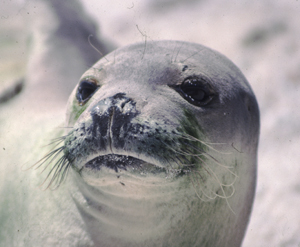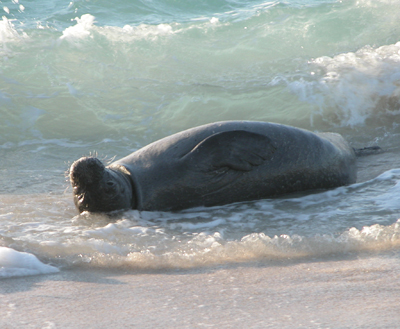Published in the Ocean Watch column, Honolulu Star-Advertiser © Susan Scott
Monday, May 7, 2012

A young Hawaiian monk seal. ©Susan Scott
I wasn’t going to write about the recent Hawaiian monk seal killing, because it seemed futile. What could I say that would make a difference?
Then my inbox got a flow of emails regarding the incident, including Internet links to local, national and international reports and commentaries. I went from site to site reading what people with wide-ranging interests and backgrounds had to say about Hawaii’s seals, Hawaii’s fishermen and Hawaiian traditions.
In that, I learned that these senseless slaughters had an upside: They are bringing the community together like never before to save a native, endangered species.
In the latter part of the 20th century, Hawaiian monk seals in the Northwest Hawaiian Islands were, if not quite flourishing, at least holding their own. Since 2001, however, the population there has been in decline. They are down to about 900 individuals.
Conversely, monk seals started thriving in the main, human-inhabited islands. The increase in seal numbers here, about 200 now, resulted in federal officials proposing last June to expand the Hawaiian monk seal critical habitat in the main islands.
A firestorm ensued, with some Hawaii anglers voicing strong opposition to the proposal, fearing fishing restrictions and bans on using beaches. Untruths began circulating. One outlandish rumor had it that monk seals are not native to the main islands.
Since then four adult seals have been found shot or bludgeoned to death — two on Molokai, two on Kauai.
The truth is that expanding monk seal critical habitat in the main islands neither limits public access to beaches nor adds new restrictions on fishing. The designation helps the seals by protecting shorelines from hotels and highways, and fishing grounds from offshore fish farms. Having monk seal critical habitat in the main islands also means that Hawaii would receive federal funds to help the seals’ survival.
To counter these terrible killings, concerned individuals have teamed up with more than a dozen local and national organizations to create a group voice. The alliance calls itself Aloha Kanaloa Coalition, Kanaloa being god of the ocean in ancient Hawaiian tradition.

The purpose of the coalition is to stop monk seal killings through education, and to open dialogue with anglers about the importance of monk seals to the Hawaiian culture, the state and the world.
The group created a public service video about the monk seal at www.alohakanaloacoalition.org. The filmmakers convey Hawaiian culture at its finest and traditional fishing practices at their wisest. The message of sharing and aloha for native species, as well as for each other, gives me hope.
One voice calling for a halt to the brutal killings of our state marine mammal won’t likely make a difference, but thousands together will.
If you have any information about these killings, please call toll-free 855-DLNR-TIP (855-356-7847). Besides holding the possibility of receiving a $40,000 reward, it’s the right thing to do for Hawaii.
©2012 Susan Scott